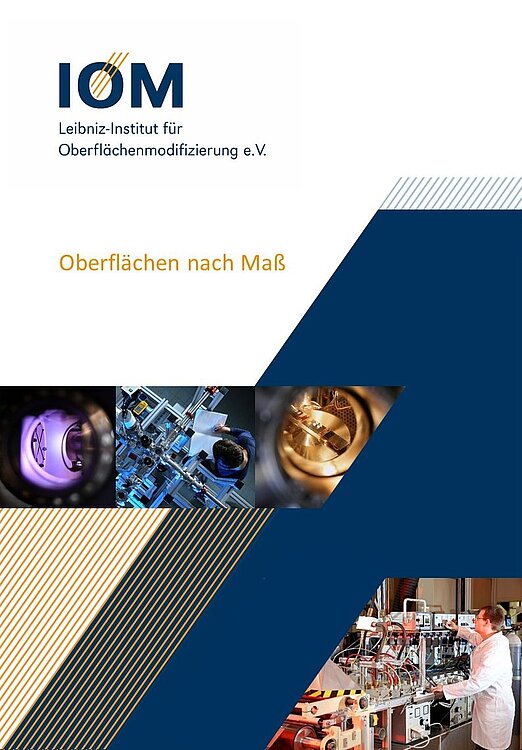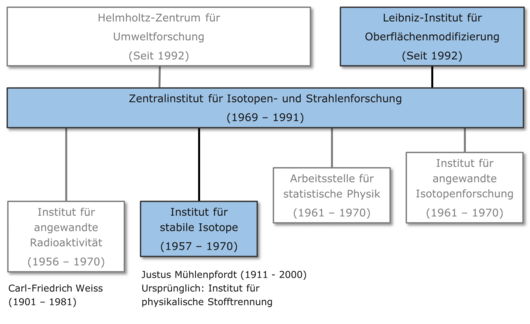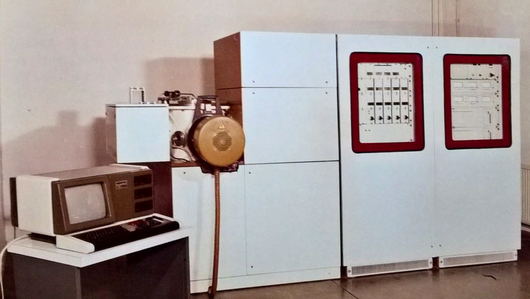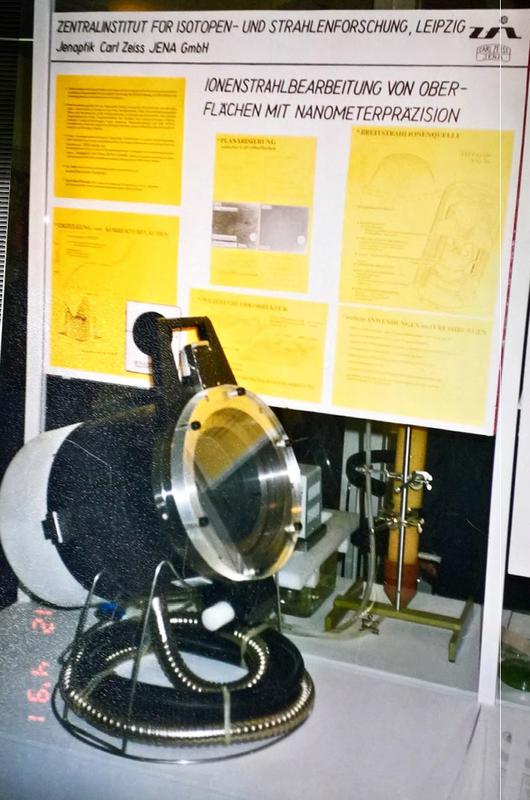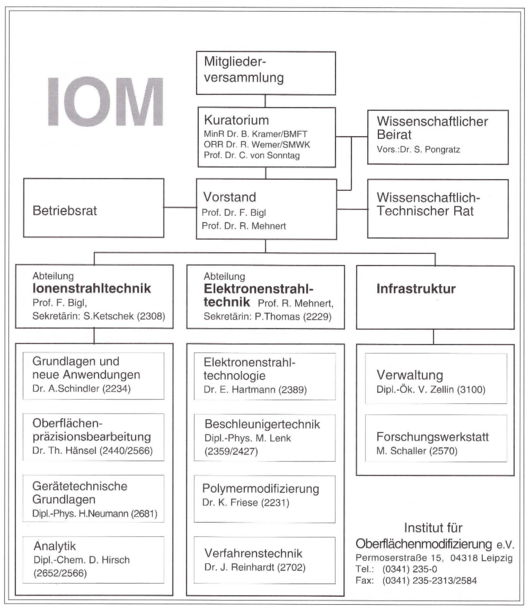The Leibniz Institute of Surface Engineering (IOM) is a non-profit, non-university research institute in the legal form of a registered association (e.V.). The purpose of the association is the application-oriented basic research in the field of non-thermal material conversion as well as the apparative and procedural developments of ion, electron, photon and plasma tools with the aim of surface modification (such as smoothing, structuring, coating, functionalizing) and the technological implementation of results in industry and society.
In accordance with the research strategy of the IOM, the technological competences of the institute are further cultivated and expanded in the purpose-oriented orientation of the scientific work, and the various expertise from physics, chemistry and engineering sciences (and to a smaller extent also biomedical sciences) are combined in a targeted manner. Accordingly, the further development of methods and beam tools (ions, electrons, photons, and plasma) occurs as they are needed to address key societal challenges.
IOM Mission:
Combining our expertise in science and engineering, we research, develop, and use beam-based methods to fabricate and process surfaces and materials with ions, electrons, photons, and plasmas. Our scientific knowledge serves the public interest and benefits society in forward-looking application fields such as optics, semiconductors, energy, biomedicine, and water management. The IOM thus contributes to the technological sovereignty and sustainable development of Europe.
IOM Vision:
The IOM is the Leibniz Center of Excellence for the design, fabrication and modification of innovative surfaces and materials applied in societally relevant future fields. Following the innovation chain from the idea to the application, the IOM sees itself as a holistic strategic partner for research and industry.
By means of an active personnel development policy and the provision of excellent working conditions, the IOM ensures that its employees and, in particular, young scientists are able to make creative, scientific contributions. At the IOM, gender equality and work-life balance are an important part of the institute's culture and are expressed through regulations and measures geared towards this.
Facts and Figures
Finances
Institutional funding by federal and state governments 2023 (in million EUR): 10.3
Third-party funding received 2023 (in million EUR): 5.6
Share of third-party funding in the total budget: 35%
Publications
Total publications 2023: 85
Thereof in peer-reviewed journals: 74
Intellectual property rights
Patents: 62
Utility models: 2
Staff
Total number of employees (2023): 129
Thereof:
Scientific staff: 75 (60.8 FTE), 17 of whom are women (23%)
Technical staff: 35 (31.9 FTEs)
Administrative staff: 11 (10.4 FTE)
Other (scholarship holders, academic staff, trainees): 8 (5.4 FTE)
Promotion of young scientists
PhD students: 26 (including 5 women)
Completed doctorates 2023: 5
Diploma, Master's or Bachelor's students: 28 (including 6 women)
Master and diploma theses 2023: 5
Bachelor theses 2023: 5
History
History
A contribution to the history of the IOM
(Pre)History of IOM C. Bundesmann
C. BundesmannThe Leibniz Institute for Surface Modification e.V. (IOM) was founded on 01.01.1992 on the recommendation of the Science Council. This recommendation was a consequence of German reunification and was based on many years of successful preliminary work at the Central Institute for Isotope and Radiation Research (ZfI), a research institute of the former Academy of Sciences of the GDR (AdW).
In 1945, the German Academy of Sciences in Berlin (DAW, renamed AdW in 1972) was reopened by order of the Soviet Military Administration in Germany (SMAD). Following the Soviet model, it was not to be a purely learned society, but was also to conduct its own research. Furthermore, in 1955 the Council of Ministers of the GDR passed a resolution on "Measures for the Application of Atomic Energy for Peaceful Purposes".
As a result, two physical academy institutes were founded at the Permoserstrasse site in Leipzig in the mid-1950s [1]: the Institute for Applied Radioactivity (1956-1970, [2]) headed by Prof. Carl Friedrich Weiß (1901-1981) and the Institute for Stable Isotopes (1957-1970, originally the Institute for Physical Separation of Substances, [3]) headed by Prof. Justus Mühlenpfordt (1911-2000). Both scientists had returned from the Soviet Union in 1955, where they - like many other scientists and engineers who initially remained in the Soviet occupation zone - worked on the Soviet nuclear program.
As part of an academy reform (1968-1972), these institutes and other facilities were merged in 1969 to form the Central Institute for Isotope and Radiation Research (ZfI). Its work included isotope research, isotope application, radiation research, tracer research, and work on radiation sources and nuclear pharmaceuticals [1,4,5]. The predecessor work of the IOM took place in the field of radiation research in the departments of Prof. Frieder Bigl (ion beam technology) and Prof. Reiner Mehnert (electron beam technology).
At the beginning of the 1970s, the development of low-energy broad-beam ion sources began in the Ion Beam Technology department. Extensive equipment developments were carried out, culminating in the fully automatic ISA 150 ion beam system with the ISQ 76/150 ion beam sources suitable for reactive gas, developed in 1983/84 in cooperation with VEB Hochvakuum Dresden (HVD) [6], and a large number of applications were investigated. Examples are the generation of bevels with smallest inclination angles (minimum 0.0005°) for depth profile analysis, reactive ion beam etching for smoothing and shaping of optical surfaces or for structure generation of semiconductors, respectively ion beam deposition. In the Electron Beam Technology department, low-energy electron accelerators were developed, among others, which were used for electron beam hardening or for the generation of beam effects in semiconductors, polymers, feed and food. Furthermore, selected beam effects were investigated. This work was very successful and some of it was also outstanding in international comparison. However, due to the political and economic situation, the developments could only find limited expansion, especially outside the GDR.
This changed in 1989 with the collapse of the GDR, as a result of which new collaborations beyond the Iron Curtain became possible and were initiated immediately. However, the political upheaval also resulted in fundamental organizational changes in the structure of the ZfI. With the reunification of the two German states on the horizon, it was decided to dissolve the academy institutes and - if of particular importance - to integrate their work into a unified German research landscape [7]. The Science Council was then commissioned to evaluate the research capacities of all academy institutes and to develop proposals for their reorientation. This could mean that work should be discontinued, transferred to independent institutes or universities, integrated into existing institutes, or outsourced to companies.
With reference to the IOM, the German Council of Science and Humanities, when evaluating the ZfI, stated, among other things [8], that the following work on ion and electron beam technology is of "fundamental interest for the further development of process technologies for non-thermal material conversion and material processing": Electron beam technology for mass conversion, polymer modification, electron beam curing of solvent-free monomer/oligomer layers, microstructuring, and surface precision machining.
It was therefore proposed to "establish a Blue List institute to conduct application-oriented basic research on the interaction of radiation with matter, including elucidating the mechanisms of radiation-induced reactions, improving the understanding of etching and deposition processes, and translating the knowledge gained into technological applications. The development of powerful broadband radiation sources also plays an important role in improving process technologies."[8]
As a result, a founding committee headed by Prof. Klaus Bethge (Johann Wolfgang-Goethe University Frankfurt am Main) was formed in the spring of 1991 under the working title "Institute for Non-Thermal Material Conversion Leipzig". As a result of intensive and diverse discussions, the Institute for Surface Modification e.V. was founded on 01.01.1992. Prof. Bigl became founding director and at the same time head of the department of ion beam technology, Prof. Mehnert became deputy director and head of the department of electron beam technology.
Like the entire social upheaval in the former GDR, the transition from the ZfI to the IOM was a difficult task associated with many personal fates. Looking back, Prof. Bigl wrote about it [9]: "The two predominantly unpleasant and thankless years of the ZfI dissolution ... were followed by the most exciting and most beautiful years of my 40 years of activity at the research site Permoserstraße 15. I was allowed to participate in the establishment of a new institute, which used ideas, methods and procedures already matured at the ZfI as starting capital and ... successfully developed them further." [9] In recognition of his special services "in the reorganization of science and research in the Free State of Saxony and in their integration into the federal structures of the Federal Republic of Germany", Prof. Bigl was awarded the Federal Cross of Merit 1st Class in 2001 [10].
Today, the IOM is an established and successful research institute, a nationally and internationally valued cooperation partner of universities, research institutes and industrial companies. All this would have been impossible without the preliminary work at the predecessor institute ZfI and the dedicated and ambitious efforts of the founders of the IOM.
References
- [1] UFZ, Leipzig Permoserstraße: Zur Geschichte eines Industrie- und Wissenschaftsstandorts, Passage-Verlag Leipzig, 2001, ISBN 9783932900617
- [2] W. Herrmann, Zehn Jahre Institut für angewandte Radioaktivität, Isotopenpraxis 2 (1966) 49; DOI: https://doi.org/10.1080/10256016608551747
- [3] J. Mühlenpfordt, Das Institut für stabile Isotope, Leipzig, Isotopenpraxis 2 (1966) 113; DOI: https://doi.org/10.1080/10256016608551720
- [4] K. Wetzel, 15 Jahre Zentralinstitut für Isotopen- und Strahlenforschung der AdW der DDR – Ein Überblick, Isotopenpraxis 20 (1984) 365; DOI: https://doi.org/10.1080/10256018408623380
- [5] K. Wetzel, H. Hübner, 20 Years Central Institute of Isotope and Radiation Research – A Review of the last 5 Years, Isotopenpraxis 25 (1989) 421; DOI: https://doi.org/10.1080/10256018908624174
- [6] F. Bigl, Ionenstrahlätzen – Verfahren und Ausrüstungen für die Mikrostrukturierung, Isotopenpraxis 22 (1986) 430;DOI: https://doi.org/10.1080/10256018608623720
- [7] Bundesminister für Forschung und Technologie (BMFT), Weichenstellung für eine künftige gesamtdeutsche Forschungslandschaft, Pressemitteilung, 03.07.90, Link: https://deutsche-einheit-1990.de/wp-content/uploads/BArch-DF4-24357.pdf
- [8] Wissenschaftsrat, Stellungnahmen zu den außeruniversitären Forschungseinrichtungen der ehemaligen Akademie der Wissenschaften der DDR auf dem Gebiet der Physik (März 1991), Wissenschaftsrat, 1992
- [9] F. Bigl, Forschung nach der Wende, Journal der WGL 01/2002, S. 6-8
- [10] Medienservice Sachsen, 18.12.2001; Link: http://archive.is/INcX#selection-367.92-367.142

